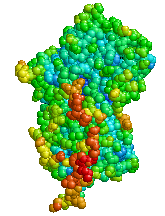Serine Protease Inhibitors,also called Serpins (from "SER"ine "P"rotease "IN"hibitors),and their homologues are a group of high molecular weight (40 to 50 kDa) structurally related proteins involved in a number of fundamental biological processes such as blood coagulation, complement activation, fibrinolysis, angiogenesis, inflammation, tumour suppression and hormone transport.
Serpins usual targets are: chymotrypsin -like serine proteases ; cysteine proteases ; other classes of protease termed "cross class inhibitors"
Serpins Classification
Inhibitors of serine proteases
Inhibitors of cysteine proteases
Cross class Inhibitors
Action Mechanism

- Pathogenic mutations in serpins could lead to inappropriate transition of the proteins.This causes disease because it reduces the amount of active inhibitory serpin
- Deficiency of many serpins may result in various diseases
Serpins Deficiencies
A number of inherited human diseases are caused by a deficiency of a particular serpin. The deficiency usually results from a mutation in the gene encoding the serpin.
Theese deficiencies lead to inappropriate conformational change and diseases.
Most common "serpinopathies"
Alpha 1 antitrypsin is one of the clinically most important serpines...
Serpins and Smoking
Cigarettes Smoking has an important role in serpins disfunction. Alpha 1-antitrypsin has been studied as a target for smoke-induced damage
Oxidative stress induces methionine oxidation and has decreased elastase inhibitory capacity.
Alpha 1 antitrypsin regulation
Alpha 1 antitrypsin structure

Alpha 1 antitrypsin and iron metabolism
Modulation of iron metabolism in monocytic THP-1 cells and cultured human monocytes by the acute-phase protein alpha1-antitrypsin. 1998
Unidirectional upregulation of the synthesis of the major iron proteins, transferrin-receptor and ferritin, in HepG2 cells by the acute-phase protein alpha1-antitrypsin. 1997
Nucleic Acids Res. 1994 Jul 11;22(13):2678-86.
Translational enhancement of H-ferritin mRNA by interleukin-1 beta acts through 5' leader sequences distinct from the iron responsive element.
Rogers JT, Andriotakis JL, Lacroix L, Durmowicz GP, Kasschau KD, Bridges KR.
Department of Medicine, Brigham and Women's Hospital, Harvard Medical School, Boston, MA 02115.
Interleukin-1 beta (Il-1 beta), a key cytokine in the acute phase response, elevates hepatic expression of both the heavy (H) and light (L) ferritin subunits without influencing the steady-state levels of either ferritin transcript. Transfection experiments with human hepatoma cells reveal that sequences within the 5' untranslated region (5'UTR) of H-ferritin mRNA confer translational regulation to chimaeric chloramphenicol acetyl transferase (CAT) mRNAs in response to Il-1 beta in the absence of marked changes in CAT mRNA levels. Il-1 beta dependent translational enhancement is mediated by a distinct G + C rich RNA sequence within 70 nucleotides (nt) of the start codon. The upstream Iron Responsive Element RNA stemloop does not confer increased expression to CAT mRNA in Il-1 beta stimulated hepatoma transfectants. A 38 nucleotide consensus sequence within the 5'UTRs of the mRNAs encoding the hepatic acute phase proteins alpha 1-antitrypsin (alpha 1AT), alpha 1-acid glycoprotein (AGP) and haptoglobin (Dente et al., 1985) is similar to sequences in the G + C rich H-ferritin mRNA translational regulatory element. Deletion of three nucleotides from this region of the 61 nt G + C rich element in the H-ferritin mRNA 5' leader eliminates Il-1 beta translational enhancement of the CAT reporter transcripts.
Ferritin translation by interleukin-1 and interleukin-6: the role of sequences upstream of the start codons of the heavy and light subunit genes. 1996